F1: 2023 Belgian Grand Prix at Spa Preview
The final event before the F1 summer recess will take the F1 Teams to Circuit de Spa-Francorchamps, for the Belgian Grand Prix.
Spa-Francorchamps is a name that evokes emotions, memories, legends. It’s a track that always produces spectacular racing, one steeped in tradition and that old-school feel of motorsport. It’s a feature of the calendar that teams, drivers and fans look forward to with a sense of profound reverence.
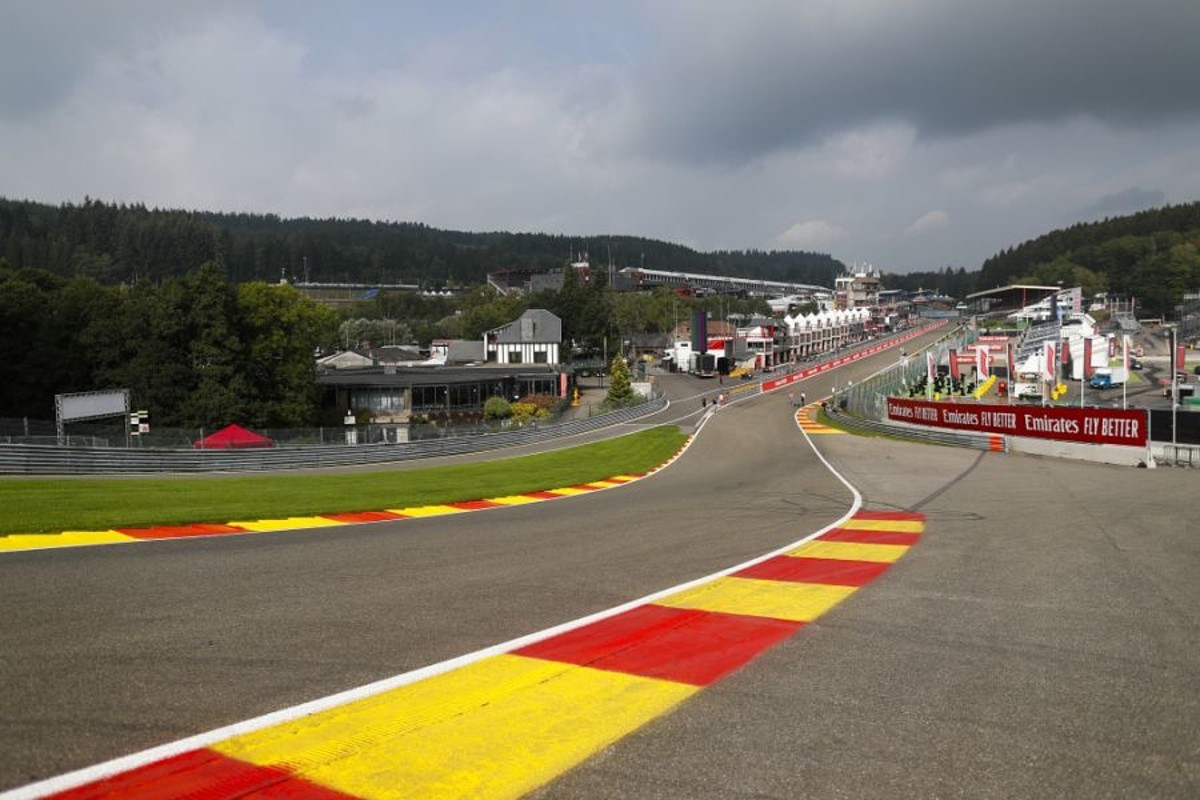
Spa used to be synonymous with the restart of the season, after the summer break. It was a return to action after the holidays, a chance to get back with a fresh mindset: not this year. This time around, teams head to Spa for the final race of the first part of the season – and for what promises to be an exhilarating Sprint race in store for them.
An event on a track of such epic proportions – in length, in gradient, in history – gets an extra twist: an all-important Friday of practice and qualifying is followed by a Saturday of end-to-end competition, ahead of Sunday’s spectacular. In the final act before the intermission of our summer break, we dig deep to find that extra bit of performance, the motivation and the strength to fight this crucial battle – and to race not once, but twice. We do so with the support of our fans, the commitment of our team both trackside and at home, and every ounce of our drivers’ skill – on a track that knows how to reward the human factor.
The Belgian Grand Prix may have moved its location in the calendar, but its place in the collective imaginary of Formula One is not diminished – it is aggrandized. No longer a welcome return to action, it is now a superb crescendo before the holidays. The resilience and commitment of those competing this weekend will be no different from the previous years: but this Sprint weekend will magnify it into something special – and there’s no better way to race in Spa.
Last year, Max Verstappen won going away after starting 14th in the race.
History
Motor-racing has been taking place in the Ardennes Forest close to the thermal town of Spa for over a century. Originally, a triangle of public routes linking the villages of Francorchamps, Malmedy and Stavelot was outlined, and it formed the basis of the circuit for the Belgian Grand Prix. It was part of Formula 1’s inaugural championship season in 1950 but the evolving sport soon outgrew the road-based 14km layout on safety grounds, and after 1970 it was dropped.
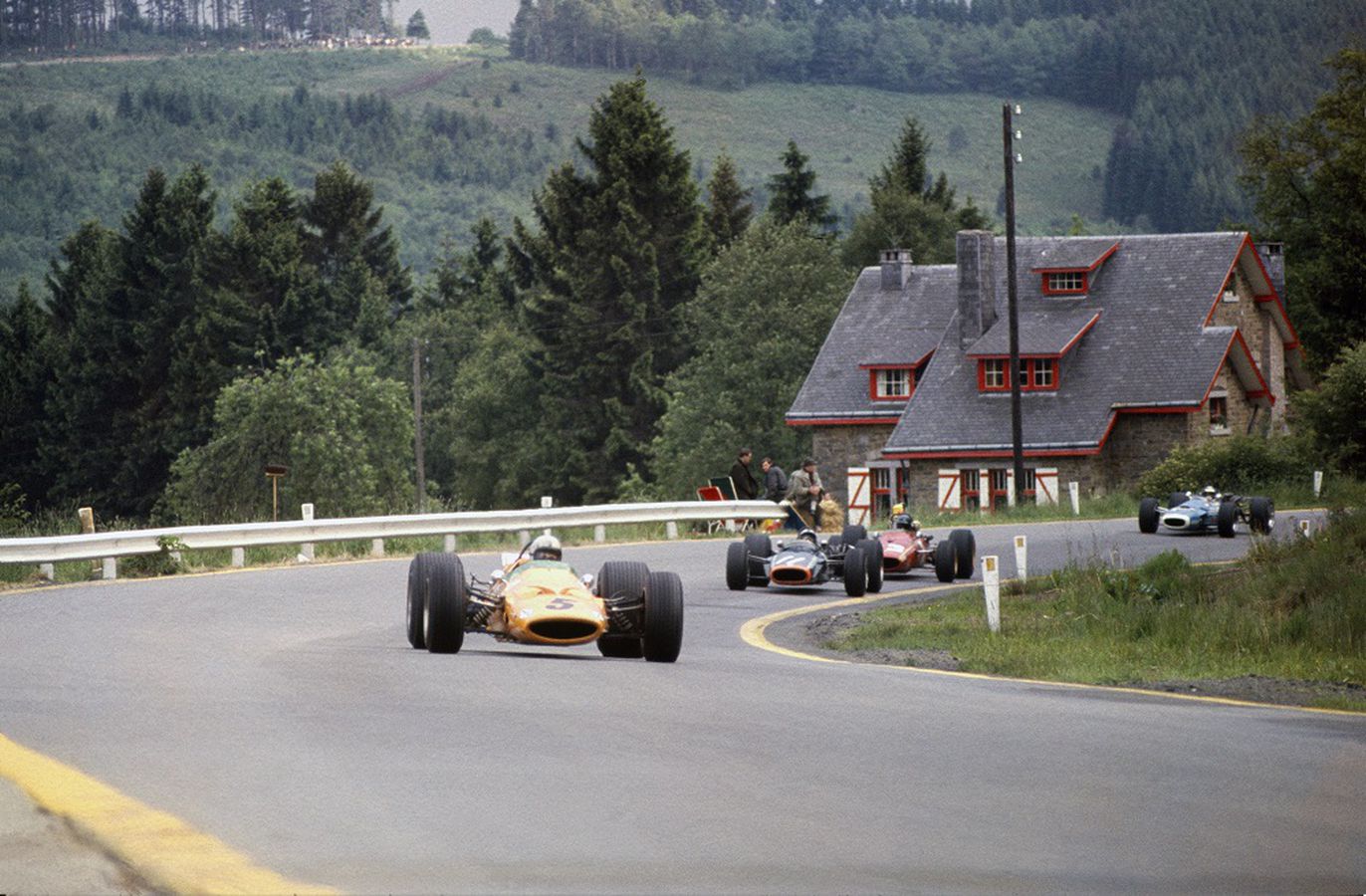
After a stint at the unpopular Nivelles and Zolder circuit, Formula 1 returned to a renovated Spa-Francorchamps in 1983, with portions of the old layout retained but the sweeping road section towards Stavelot bypassed. Nevertheless, the new Spa-Francorchamps swiftly received widespread acclaim and remains among the most-loved circuits on the current calendar by drivers and teams alike. For 2023 the event has moved from August to July as the final race prior to Formula 1’s summer recess.
This is a Sprint Race weekend, which means that we have just a single practice session to set the car up ready for the unique demands of Spa.
As a result of the long lap, the drivers will get very few laps before they enter the Friday evening qualifying session. The weather forecast is for mixed conditions, which will only add to the pressure on the teams.
The Spa circuit presents a great challenge, combining long straights with significant corner sequences; the trade of downforce and drag is difficult to optimize, especially in the wet.
At 7km, Spa-Francorchamps is the longest circuit on Formula 1’s current calendar, with a lap taking drivers on an undulating journey through the Ardennes Forest. The circuit, a steep challenge for drivers, also provides a set-up quandary for teams. High downforce is preferred for the long-radius corners that comprise the long middle sector of the lap, but top-end speed is essential for the lengthy full-throttle blasts of the first and final sectors, which include the renowned flat-out Eau Rouge/Raidillon and Blanchimont curves respectively.
The microclimate around Spa-Francorchamps can intervene, even in the height of summer, with temperature fluctuations and wet weather likely to influence proceedings. As the old saying goes: if you can’t see the forests it’s raining, and if you can see the forests, well, it’s going to rain.
This year’s Belgian Grand Prix will feature F1 Sprint, the first time that the two-race format has been held at Spa- Francorchamps. It will be the third of six presences for F1 Sprint in 2023.
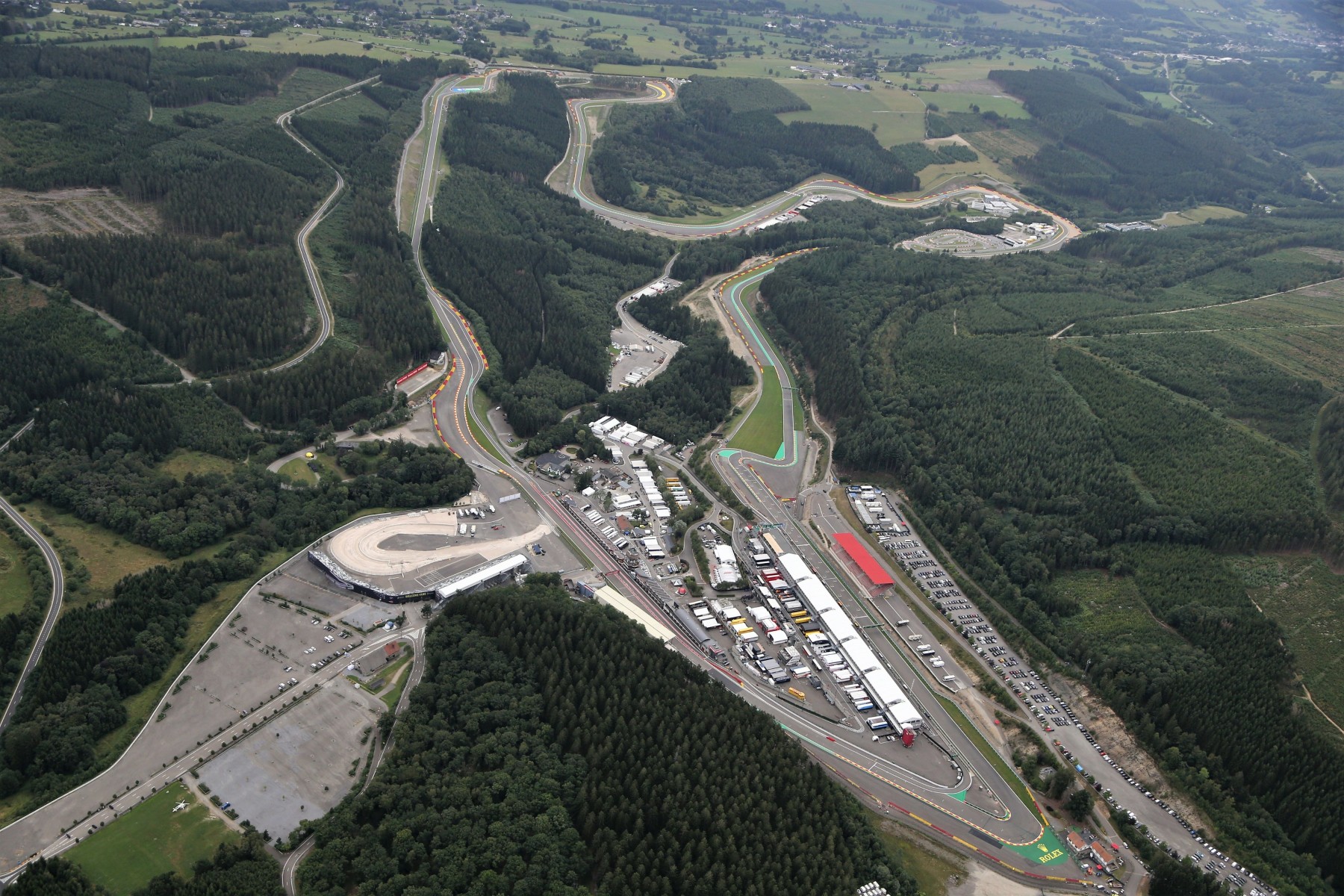
At its opening in 1921, the racetrack was a 15-kilometre triangular course consisting of public country roads between the towns of Spa, Stavelot and Malmedy.
The first Belgian Grand Prix was held in 1925. The circuit hosted a Formula 1 race in the 1950 debut season of the championship. In 1979, safety issues led to the former “fastest open road circuit in the world” being shortened to a permanent racing circuit, which today measures 7.004 kilometers in the Grand Prix version. The latest upgrades have improved the run-off areas in the legendary Eau Rouge/Raidillon combination. Additional grandstands were added here and at other locations along the racetrack.
The circuit remains one of Formula 1’s finest, featuring several iconic corners, most notably the steep rise through Eau Rouge/Raidillon, the high-speed Pouhon and Blanchimont corners, and the twisty Bus Stop chicane. It requires a set-up compromise, with the first and third sectors almost entirely dependent on top-end speed, segmented by a second sector that is reliant on downforce.
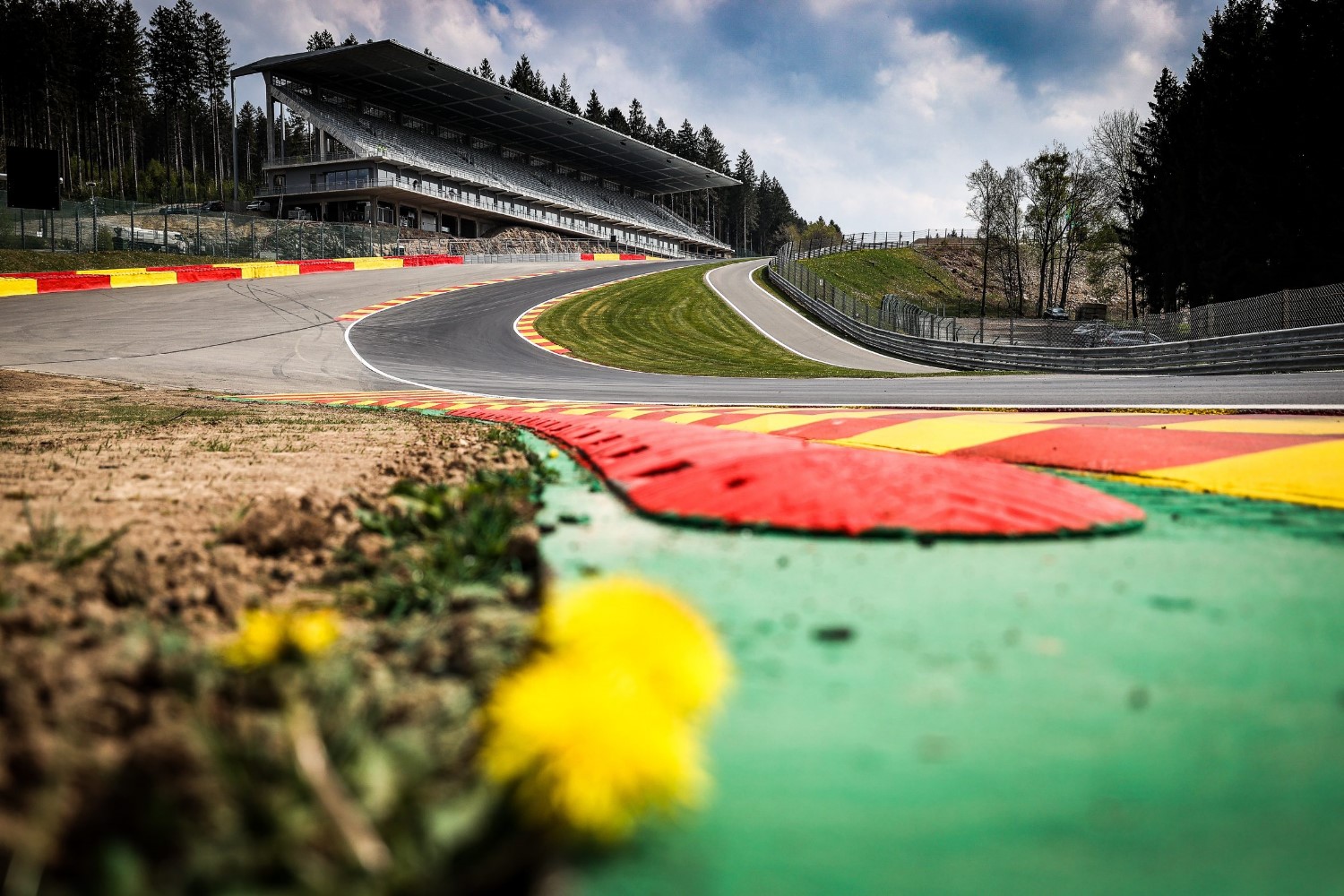
Weather: The weather at Spa is among the least predictable on the calendar. Rain is almost always a factor during the weekend, and it is very tricky to forecast. Given the length and range of the circuit, one sector can be soaked even when the others are perfectly dry.
Forecast:
The weekend is set to be cloudy with rain falling regularly throughout, but as things stand, the current forecast is for rain only in practice on Friday and not Qualifying.
It is predicted the rain will move away to the northeast – away from the Kemmel Straight – with the sun expected to break through for Qualifying. The temperature is set to be around 21 degrees Celsius.
Both Saturday’s sprint Qualifying and the sprint itself are expected to be wet – with the last sprint race also being wet in Austria. However, teams must keep a close eye on the radars as the rain is expected to move around the track with the sun peeping through.
As for the race, there is a chance of showers on Sunday, with the sun maybe drying the track if it can break through the cloud cover.
Temperatures will be cool at 18 degrees Celsius with a moderate westerly wind, blowing across the track from left to right across the Kemmel Straight as the drivers look.
Race interruptions: Safety Cars are to be expected at Spa. All but two races have seen a Safety Car deployment since 2014, but there have only been two Virtual Safety Car deployments since 2015 when the system was introduced.
Overtaking: Overtaking difficulty is average at Spa. The long DRS run to Turn Five is the favored passing opportunity but the Bus Stop chicane provides another strong opportunity. Last year’s Belgian Grand Prix saw 60 passes, excluding starts and restarts.
Strategy: Like last year, the C2, C3 and C4 compounds have been supplied by Pirelli. However, Sprint rules come into play: SQ1 and SQ2 must be run on the Medium (C3) tires. Last year’s Belgian Grand Prix saw high tire degradation and a two-stop race.
Unlocking the Lap
Turn One offers the immediate challenge of La Source, the setting for many infamous opening-lap collisions over the years. It’s a tricky hairpin whose exit is key to the lap. That’s because it leads into a mile-long flat-out sector all the way up to Turn Five.

The challenge of turns 10 and 11 – Pouhon – makes it hugely popular with the drivers. It’s an almost flat-out, double-apex, downhill left-hander, which is hard to get right. A new gravel trap lies beyond the existing Tarmac run-off, adding another layer of peril for the drivers.

Turn 14 is another key corner that precedes a long flat-out section, this time towards the end of the lap. It’s a downhill corner, deceptively tight, where it is easy to run wide. A good exit offers the opportunity to slipstream rival drivers and set up an overtake into the chicane at the end of the lap.
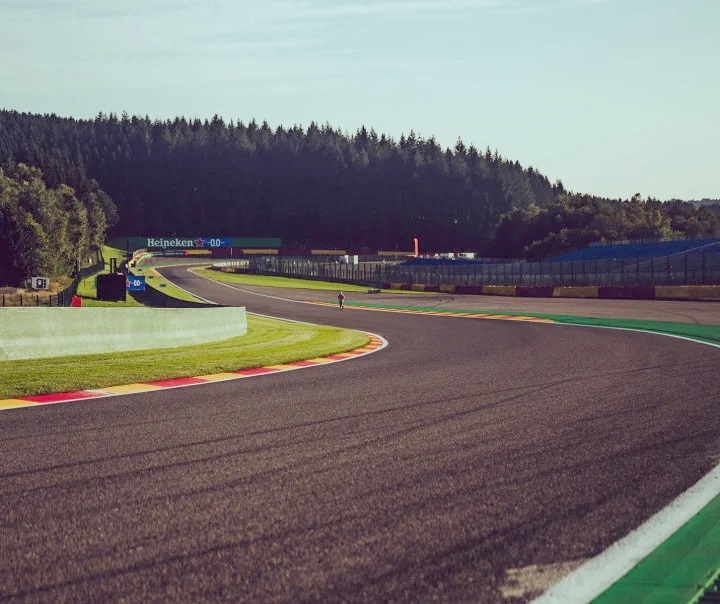

Belgian Grand Prix: facts & figures
0. No Belgian driver has won their home Grand Prix in the 67 editions held so far. 24 Belgians have raced in Formula 1, winning 11 times, (eight courtesy of Jacky Ickx and three for Thierry Boutsen) but none of those were at Spa-Francorchamps, nor at Zolder and Nivelles, the other two venues that have hosted this event. Only Monaco has a worse record in this respect, with no Monegasque drivers winning any of the 69 races held there. But the Principality could only count on five standard bearers in Formula 1, including Charles Leclerc.
4. They say only the greats win at Spa-Francorchamps and the figures tend to confirm that. Only four drivers took their maiden Formula 1 victory at the Ardennes track: Peter Collins in 1956, in a Ferrari D50, who was destined to be a world champion if he had not died when still very young in 1958; Jim Clark in 1962 in a Lotus, who went on to win the championship twice; seven times world champion Michael Schumacher in 1992 for Benetton and Charles Leclerc in 2019 in the Ferrari SF90.
800. The number of comic book writers from Belgium, the country regarded as the home of the comic or the “ninth art” as it is known. There are over 700 of them in Brussels alone. The pioneering cartoon character was Tintin, the likeable and intrepid redheaded boy, whose books have been translated in over fifty languages. His adventures began in 1929 in the pages of a kids’ comic, Le Petit Vingtieme. Other famous Belgian comic characters are Lucky Luke (1946), Gaston Lagaffe (1957) and especially the Smurfs, created in 1958, who went on to greatly influence popular culture in the second half of the last century for quite some time.
1700. The number of special beers available in just one specific bistro in Brussels, which is now a must-visit for fans of this drink, which Belgium produces in incredible quantities and varieties. It is reckoned that, every year, Belgians down 70 liters of beer per head, which is equivalent to half a pint per day.
1846. The year in which the saxophone was first produced. The musical instrument was invented by the Belgian Adolphe Sax, who combined the simple reed mouthpiece of a clarinet with the body of an ophicleide, a family of conical-bored instruments and the oboe and flute. This hybrid produced great volume similar to brass instruments, but even though it is made of brass, it is considered a woodwind instrument, because of its use of a single reed. It was first shown at the Industrial Exhibition in Paris in 1844 and was patented two years later.
Fact File: Belgian Grand Prix
- Spa-Francorchamps is the longest lap distance on the F1 calendar, measuring 7.004 kilometers. It also has the lowest number of race laps, with just 44.
- It used to be one of the biggest challenges for engine duty and time spent on full throttle, but with the new regulations and new tracks joining, it has fallen down the list. It still remains in the top five, though.
- Despite several long, flat-out sections, Spa is middle of the pack when it comes to fuel consumption, as constant stop/start is what uses the most fuel – so tracks such as Montreal and Monaco are higher on fuel consumption, compared to Spa and Monza.
- Tyre duty and wear are some of the highest of the season at Spa, with high averages across all four corners of the car.
- The long lap distance at Spa brings with it a few unique challenges. For example, if a car gets damaged early in the lap, more time is lost getting back, and the weather is very changeable so conditions can vary massively from corner to corner. And it means the lap takes longer to complete; therefore you can’t fit as many laps into practice and qualifying run plans to test different setup configurations.
- From the exit of La Source to the braking zone for Les Combes, the drivers have their foot firmly on the throttle for around 23 seconds (and 1,875 meters) of track layout.
- Because of this flat-out section, the exit of La Source is incredibly important, as it leads down the long straight to Eau Rouge and Raidillon.
- There’s a difference of around 100 meters between the highest (Les Combes, Turn 7) and the lowest point (Stavelot, Turn 15) on the track, the highest elevation change of the season.
- The drivers and cars typically experience a heavy compression of forces through the downhill entry of Eau Rouge and the uphill exit of Raidillon. They are travelling at pretty much Vmax (maximum velocity of the car), almost as fast as the car can go before heading through this section. This means there is 3g of vertical compression. Some resurfacing and reshaping has taken place through this section, which may well have eliminated one of the biggest bumps and softened the compression forces slightly.
- The tow at Spa-Francorchamps is very powerful due to the long straights, particularly the section after Raidillon. On the first lap this is even more powerful, because drivers chasing can pick up a tow from multiple cars. The lack of DRS on lap one also increases this effect.
- 80% of the lap distance at Spa is taken at full throttle, one of the highest percentages of any F1 track on the 2022 calendar.
- The first and third sectors at Spa feature long straights and flat-out sections, but the second sector is twisty. This makes it challenging to find the right balance and set-up compromise, particularly with the wing level. A bigger wing will gain time in the middle sector but leave you vulnerable on the straights, while a smaller wing will provide less drag for the flat-out sections but not providing the same level of grip in the twisty corners. This is a similar predicament to Baku.
- Because of the track’s history and iconic corners, this is one of the few tracks in F1 where engineers tend to refer to the turns by name rather than number.
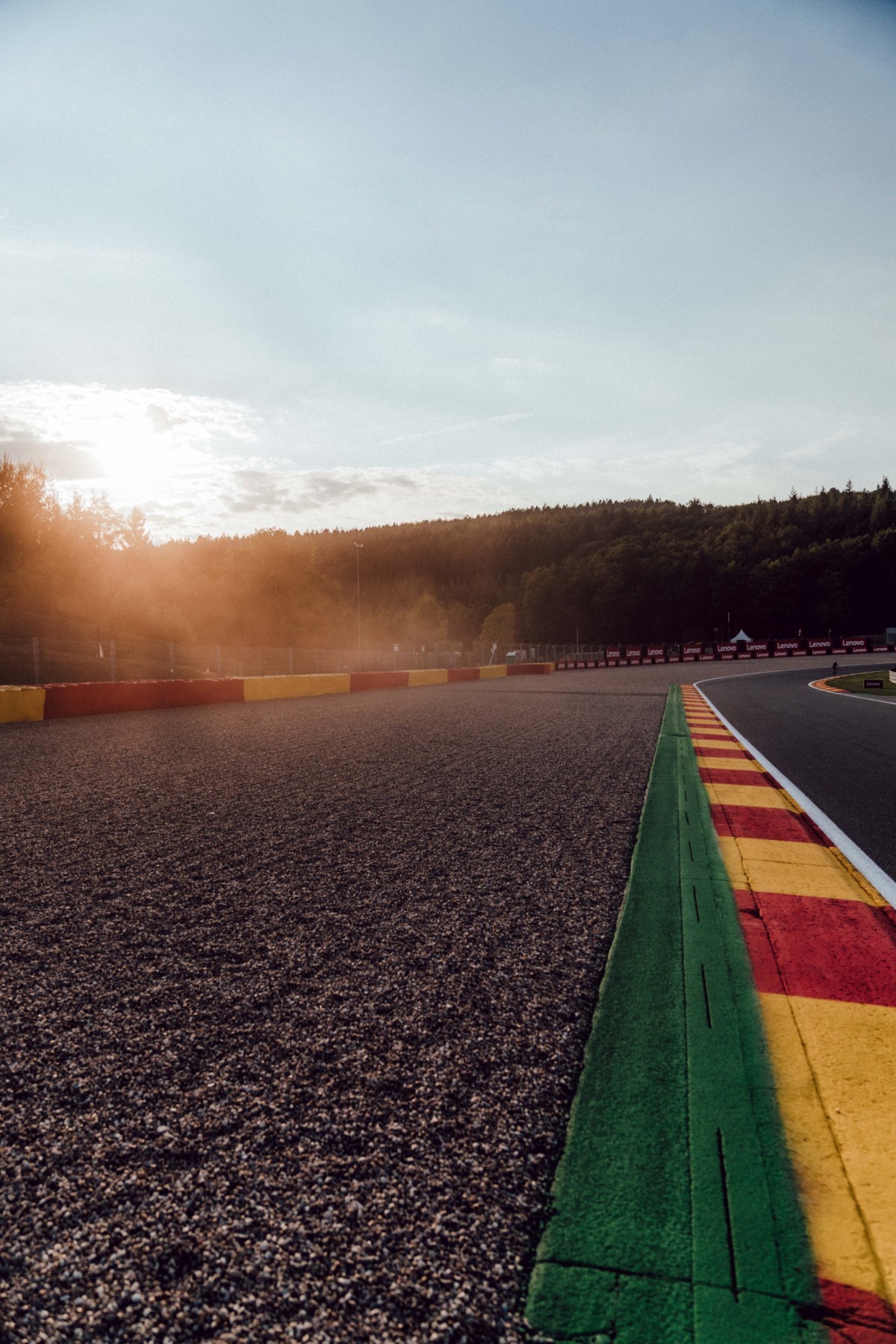
Daniel Ricciardo’s Perspective
“My whole weekend in Budapest was really good, making me feel all the things I missed, like the adrenalin and being on the starting grid, those emotions are really powerful. I felt our pace wasn’t bad and there was maybe even a chance of points if I hadn’t had to start again from the back after being hit on the first lap. It was good the car wasn’t damaged, so I was able to do the 70 laps and I felt physically fine at the end of it. There were a lot of things to be happy about. I made a few little mistakes in the race, but by the last stint I was really consistent and I don’t think I could have asked for anything more from my first weekend back.
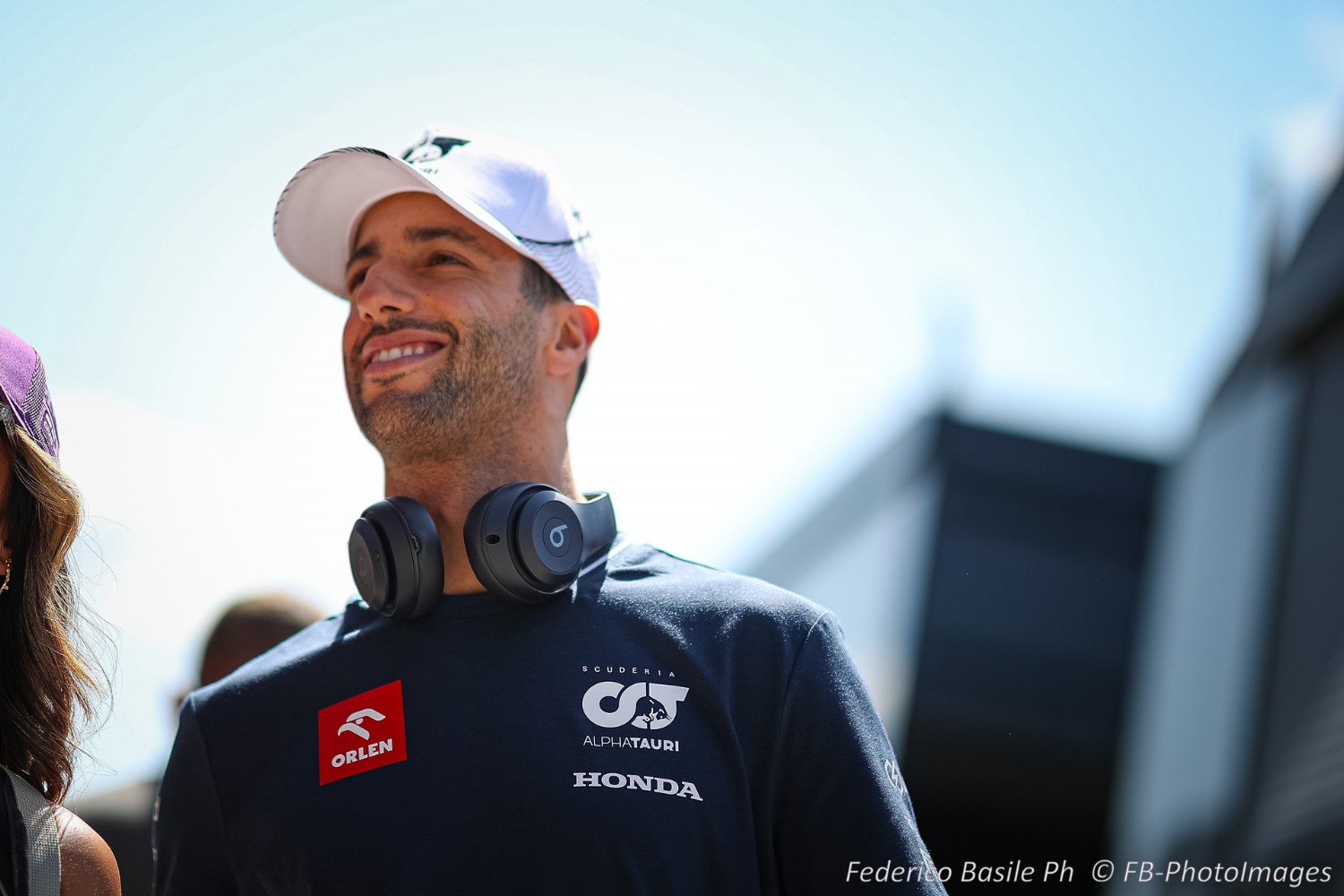
“I’m happy to have a back-to-back and go to Spa now. I think it was a solid start and it will be good to jump straight back in the car after just a couple of days, as it will keep the ball rolling. It should fast-track my learning and my improvement. That’s the plan, to keep chipping away at it.
“I think Spa is always a challenge, the circuit itself is one of the best and the weather is always a factor, but I will deal with it with confidence, after how things went in Hungary. I want to be optimistic about it, but also I have to stay grounded, as there are still a lot of things to learn. It’s a Sprint format, which means it will be a pretty busy time, with just one practice session and then straight into qualifying. I plan to log a lot more laps, have some fun, and try to get in the points on Sunday.”
Pirelli Tires
Tire compounds are from the middle of the Pirelli range and are the same as we used a few weeks ago in Budapest. However, the behavior of the tires will be quite different at this circuit, and teams will need to spend Friday understanding how to maximize their performance here.
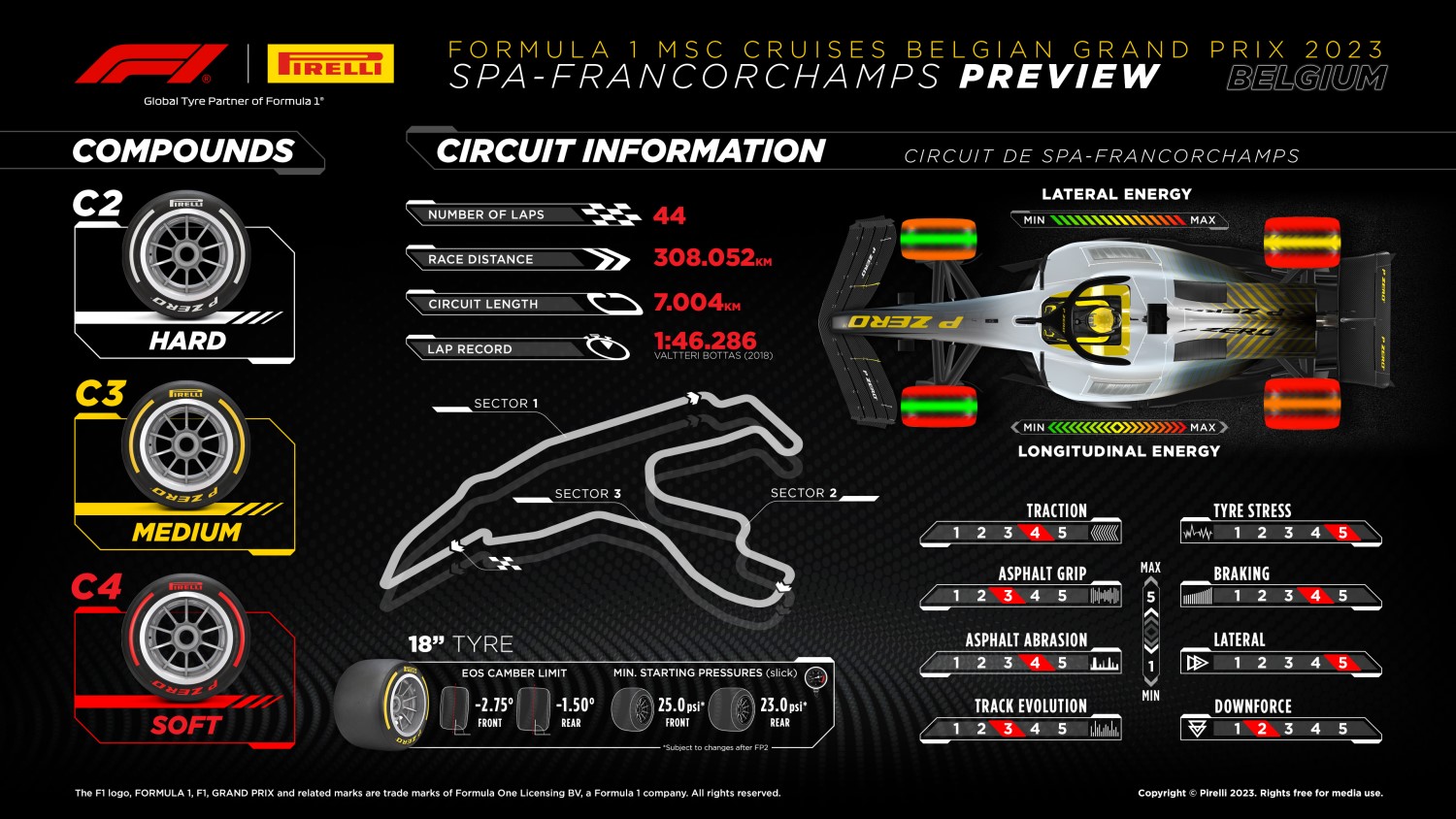
MARIO ISOLA – MOTORSPORT DIRECTOR
“New changes bring new challenges, but the epic nature of Spa is still the same”
After just a couple of days off, there’s another Formula 1 race this weekend: the last before the summer break. The Belgian Grand Prix is one of the most prestigious races on the calendar, held on a track that’s particularly challenging for drivers, cars, and tires.
We’ve nominated the same line-up of compounds as last year – C2, C3, and C4 – to offer a wide range of strategy options; at least if the rain holds off. Traditionally, the weather at Spa is a key factor throughout the weekend; the fact that the grand prix has moved dates – from the first race after the summer break to the last race before it – should make little difference, as the forecast is always variable anyway.

The length of the track, with Spa being the longest lap of the year, and the variation in elevation – which is also the biggest of the whole season – means that it’s easy to find wet conditions on one part of the track while it’s completely dry elsewhere. New for this year is Spa becoming the third Sprint venue of the season, after Baku and Spielberg, with a Sprint Shootout on Saturday morning followed by a 100-kilometre race in the afternoon.
With just an hour of free practice before qualifying on Friday (which, for now, seems to be the day most at risk of rain) there will be even less time than usual to set up the cars.
At Spa, we tend to see some of the biggest differences in terms of aerodynamic setup between the teams: some prefer more downforce in order to push harder during the second sector while others prefer a looser car to have extra speed to attack and defend more down the straights. With two races this year, one of the most spectacular venues of the season is set to put on an even bigger show.”
- As was the case for the 2022 Belgian Grand Prix, the teams will have the C2 as P Zero White hard, C3 as P Zero Yellow medium and C4 as P Zero Red soft.
- Along with Silverstone and Suzuka, Spa-Francorchamps is a circuit where the tires are subjected to considerable forces. The most challenging part for tires is the compression at Eau Rouge followed by the climb up to Raidillon: consisting of a high speed left-hand turn, where the downforce squashes the car into the ground, followed by another high-speed right-left kink where the car goes light at the top of the hill onto the Kemmel straight.
- Spa is the longest track on the Formula calendar at 7.004 kilometers, with 44 laps scheduled for the Belgian Grand Prix. When the circuit was inaugurated back in 1921, it was around double the length at 14.9 kilometers.
- Last year, nearly all the teams opted for a two-stop strategy using all three compounds. Red Bull’s Max Verstappen lined up 14th on the grid after a penalty but won the race with a great fightback, starting on the softs and then completing two stints on the medium.
- Spa-Francorchamps is also a special place for Charles Leclerc, who won his first Formula 1 race there with Ferrari in 2019. The Italian team has taken the most victories at Spa (14) since 1950, while Michael Schumacher has the highest number of individual victories (six).
- The circuit also had the biggest difference in elevation of any track all year. The highest point is at Malmedy (around 468 meters above sea level) while the lowest is Paul Frere (around 366 meters above sea level). That’s a difference of 102.2 meters: more than the height of the Big Ben clock tower in London.
Point Standings
Drivers’ Standings (11 of 22 races completed)
1 Max Verstappen 281
2 Sergio Perez 171
3 Fernando Alonso 139
4 Lewis Hamilton 133
5 George Russell 90
6 Carlos Sainz Jr. 87
7 Charles Leclerc 80
8 Lando Norris 60
9 Lance Stroll 45
10 Esteban Ocon 31
11 Oscar Piastri 27
12 Pierre Gasly 16
13 Alexander Albon 11
14 Nico Hulkenberg 9
15 Valtteri Bottas 5
16 Zhou Guanyu 4
17 Yuki Tsunoda 2
18 Kevin Magnussen 2
19 Logan Sargeant 0
20 Nyck De Vries 0
21 Daniel Ricciardo 0
Constructors
1 Red Bull 452
2 Mercedes 223
3 Aston Martin 184
4 Ferrari 167
5 McLaren 87
6 Alpine 47
7 Williams 11
8 Haas 11
9 Alfa Romeo 9
10 AlphaTauri 2
